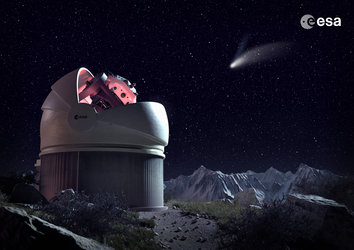Accept all cookies Accept only essential cookies See our Cookie Notice

About ESA
The European Space Agency (ESA) is Europe’s gateway to space. Its mission is to shape the development of Europe’s space capability and ensure that investment in space continues to deliver benefits to the citizens of Europe and the world.
Highlights
ESA - United space in Europe
This is ESA ESA facts Member States & Cooperating States Funding Director General Top management For Member State Delegations European vision European Space Policy ESA & EU Space Councils Responsibility & Sustainability Annual Report Calendar of meetings Corporate newsEstablishments & sites
ESA Headquarters ESA ESTEC ESA ESOC ESA ESRIN ESA EAC ESA ESAC Europe's Spaceport ESA ESEC ESA ECSAT Brussels Office Washington OfficeWorking with ESA
Business with ESA ESA Commercialisation Gateway Law at ESA Careers Cyber resilience at ESA IT at ESA Newsroom Partnerships Merchandising Licence Education Open Space Innovation Platform Integrity and Reporting Administrative Tribunal Health and SafetyMore about ESA
History ESA Historical Archives Exhibitions Publications Art & Culture ESA Merchandise Kids Diversity ESA Brand Centre ESA ChampionsLatest
Space in Member States
Find out more about space activities in our 23 Member States, and understand how ESA works together with their national agencies, institutions and organisations.
Science & Exploration
Exploring our Solar System and unlocking the secrets of the Universe
Go to topicAstronauts
Missions
Juice Euclid Webb Solar Orbiter BepiColombo Gaia ExoMars Cheops Exoplanet missions More missionsActivities
International Space Station Orion service module Gateway Concordia Caves & Pangaea BenefitsLatest
Space Safety
Protecting life and infrastructure on Earth and in orbit
Go to topicAsteroids
Asteroids and Planetary Defence Asteroid danger explained Flyeye telescope: asteroid detection Hera mission: asteroid deflection Near-Earth Object Coordination CentreSpace junk
About space debris Space debris by the numbers Space Environment Report In space refuelling, refurbishing and removingSafety from space
Clean Space ecodesign Zero Debris Technologies Space for Earth Supporting Sustainable DevelopmentApplications
Using space to benefit citizens and meet future challenges on Earth
Go to topicObserving the Earth
Observing the Earth Future EO Copernicus Meteorology Space for our climate Satellite missionsCommercialisation
ESA Commercialisation Gateway Open Space Innovation Platform Business Incubation ESA Space SolutionsLatest
Enabling & Support
Making space accessible and developing the technologies for the future
Go to topicBuilding missions
Space Engineering and Technology Test centre Laboratories Concurrent Design Facility Preparing for the future Shaping the Future Discovery and Preparation Advanced Concepts TeamSpace transportation
Space Transportation Ariane Vega Space Rider Future space transportation Boost! Europe's Spaceport Launches from Europe's Spaceport from 2012Latest

Galileos separated from Ariane upper stage
Thank you for liking
You have already liked this page, you can only like it once!
The recently separated Galileo satellites 15–18 seen in space as four closely clustered dots above their Ariane 5 EPS upper stage, which is venting propellant (the brilliant cloud from both sides of the EPS) as part of its passivation process.
The two brighter spots/areas at each side is due to the passivation process itself, in which − after the opening of the valves − the pressure falls quite quickly and therefore a higher concentration of discarded propellant is found further from the EPS.
This image was acquired by the CNES/CNRS-operated TAROT telescope on Réunion Island at 17:23 GMT (18:23 CET) on 17 November 2016, approximately 21 minutes after the second separation of paired Galileo satellites. The agile TAROT telescopes are used to hunt out optical evidence of Gamma-ray burst events as well as observe and catalogue space objects in high orbit.
About TAROT
TAROT refers to 'Télescope à Action Rapide pour les Objets Transitoires – Rapid Action Telescope for Transient Objects' and comprises a network of telescopes, which is jointly operated by the French space agency (CNES) and France's CNRS - Centre national de la recherche scientifique (Artemis and IRAP Laboratories).
TAROT consists of two 25-cm aperture instruments located at the Calern Observatory (part of the Observatoire de la Côte d'Azur, France), the La Silla Observatory (European Southern Observatory, Chile), and an 18-cm telescope at Les Makes Observatory (Reunion, France). Since 1999, TAROT has conducted observations of Resident Space Objects (RSO) − mostly debris − on geostationary orbit, and of passing objects in eccentric (such as Geostationary transfer orbit or Medium Earth Orbit). Such observations are used to feed an automatic cataloguing system of RSOs.
-
CREDIT
CNES/CNRS -
LICENCE
ESA Standard Licence

Ariane 5 ES Galileo

Galileo's Fregat separating

Webb fuelled for launch

Flyeye Observatory















 Germany
Germany
 Austria
Austria
 Belgium
Belgium
 Denmark
Denmark
 Spain
Spain
 Estonia
Estonia
 Finland
Finland
 France
France
 Greece
Greece
 Hungary
Hungary
 Ireland
Ireland
 Italy
Italy
 Luxembourg
Luxembourg
 Norway
Norway
 The Netherlands
The Netherlands
 Poland
Poland
 Portugal
Portugal
 Czechia
Czechia
 Romania
Romania
 United Kingdom
United Kingdom
 Slovenia
Slovenia
 Sweden
Sweden
 Switzerland
Switzerland

























